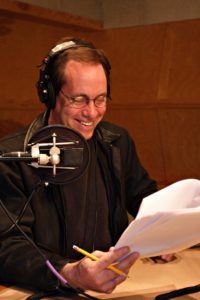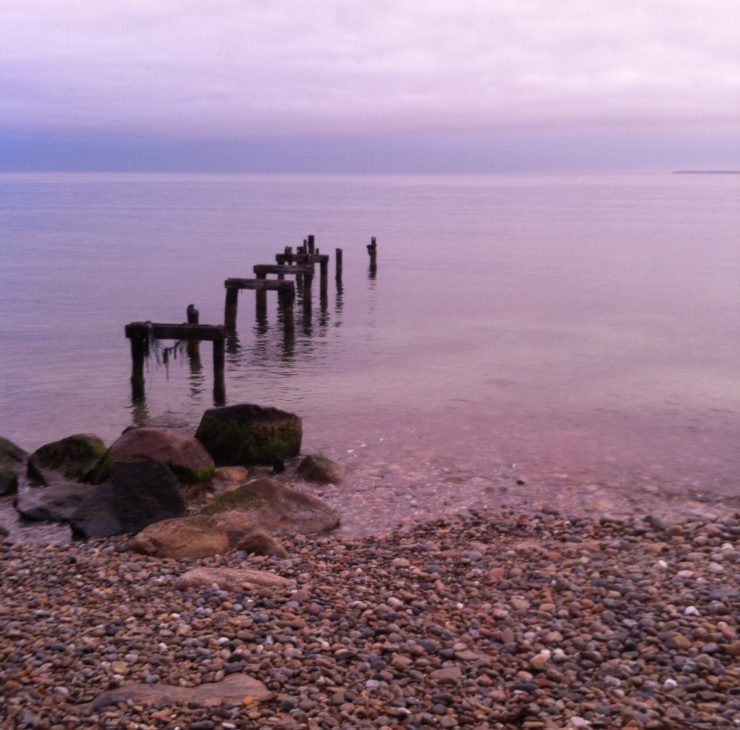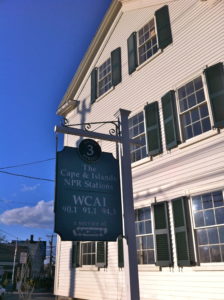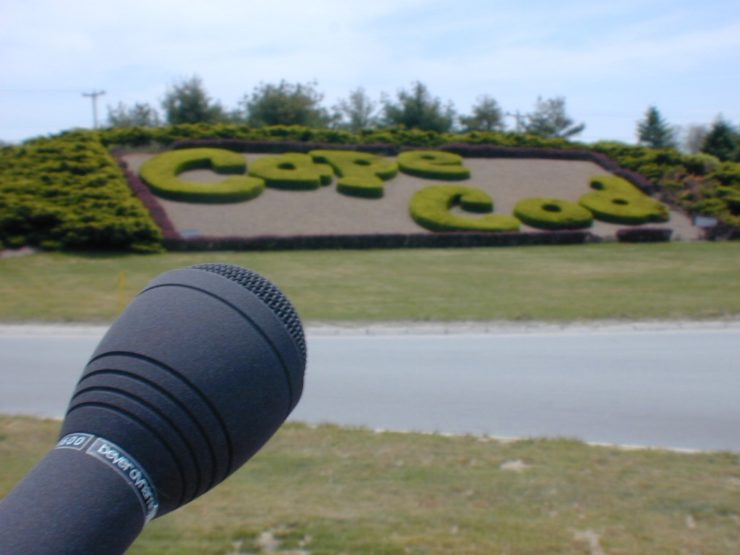Jay Allison is a pioneer in the world of radio storytelling. Nearly 25 years ago, he founded Atlantic Public Media, which in turn birthed WCAI, the public radio station for Cape Cod and its surrounding islands; the Public Radio Exchange (PRX); and Transom.org, an indispensable tool for audio story makers. Allison also produces The Moth Radio Hour.
He was recently honored at The International Documentary Film Festival Amsterdam for another, smaller, creation: Sonic IDs. Sonics are bite-sized vignettes that have aired throughout the day on WCAI since its founding instead of standard station identifications, those mandatory listener reminders of a station’s call letters.
As WCAI’s library of Sonic IDs has grown over the past 17 years, a living oral history project has taken shape.
They interrupt the expected with the voices and sounds of life on the Cape. A recent widow muses on the mental health benefits of candlepin bowling. (“Quit sitting on the couch. Quit being bored. Because there’s bowling that you can do.”) Scallops clap. (Yes, they do that.) A 12-year-old girl lovingly describes mouse dissection.
As WCAI’s library of Sonic IDs has grown over the past 17 years, a living oral history project has taken shape. Allison produces the segments with longtime collaborator and APM associate director Viki Merrick. He voices them, dipping in to relay the speaker's name, where they are or where they’re from, and ending with the station identifier.
The 30-, 60- and occasionally 90-second surprises air in interstitial time, those often-wasted gaps between daily programming. Hearing them is like falling into a world you never knew existed. The place and time: here and now. Jay and I discuss.

What was the concept at the very beginning, when you started the station? Take me back.
It was a really rare opportunity. Here you have a brand-new radio station, an empty signal. You're not hampered by legacy. You get to invent your own personality, but you don't have any money. How would we declare ourselves? We didn't want to be McPublic radio. I had this thought of using the interstitial time, thinking if we could produce tiny little slivers of localness, of character, and fundamentally of place, listeners might be reminded all day long, “Oh, that's this radio station, that's this place.” Producing in the interstitial time also fit my overall concept for the radio station, which was that it should be like a good neighbor, and one of its functions should be to introduce you to the neighbors you don’t know. You would just be interrupted in the midst of national programming and one of your neighbors would pop up, talking about life where he is right now, or when he first got here, or a thing that happened at sea to his grandfather. I think the worst ones are kind of postcard-y that give you a sort of seagull-on-the-beach a view of life here. The best ones really arrest you. You feel momentarily confused, which I think focuses your mind. It’s like if you feel like you're getting lost a little bit, you begin to pay attention to your surroundings.
They almost feel voyeuristic, like you’re looking through a keyhole into someone else's brain and seeing the world through their point of view. Were they always so intimate or have they become more so?
You know, a lot of other stations do this now, and I think the common mistake is to go to people to get them to talk about the thing they've talked about a lot. But what ends up being much more interesting is people talking about things they're unsure of or aren't their area of expertise or that just happened to them or that a book reminds them of. Then people's voices change. So many people on the radio are talking with some kind of authority. They’re being interviewed about the thing that they're good at or have knowledge of. People in Sonic IDs are not necessarily doing that. They're in conversation, just kind of musing or wondering or in pain or loss and reflection. Those kinds of qualities, you're not used to hearing them recorded and presented.
People say we think we need stories, because we think in stories. But these aren't full stories. They’re glimpses. And it seems like that's part of what makes them so effective. Why do we crave this?
They’re a little like sorbet in a big meal. They kind of clean the palate because we’re in a sea of daily information, this great tidal flow of things we're supposed to be informed about and we try to be diligent and stay abreast of that. This is a relief for that. These are moments that aren't necessarily -- in fact rarely are -- tied to that day. They're tied to the history of a person and by extension, the place we live. So as we're hearing about events around the world or events in Washington, and they're big and they're important, then we hear about a tiny thing. It doesn't seem to matter very much, but it's right here. And that, I think, reminds us that we are tiny and we are right here. And it's OK to focus there sometimes. All kinds of points of view are represented in these. You may be anti-gun, but you're listening to a gun owner talk about his guns with a certain kind of relish. And he's funny. And he's a good storyteller and he's non-threatening. And maybe your fear around the issues of guns in this country has gotten to the point that you feel like anybody who likes a gun must be in some way bad. And suddenly you have to think differently about that because you liked the guy. And I think that that gets to a core issue we have right now, which is that people kind of hate each other. And it's too easy to turn a fundamental philosophical difference with someone into a hatred for their being. These little things counter that and remind you that we're dimensional.

It seems like some of the earlier ones were more narrative, like a guy talking about how he went out on a sailboat. They've gotten more impressionistic, more about real-time moments or feelings. Is that practice? Is it the way you're culling them? Or did they turn into something more poetic than what you initially anticipated?
I think they opened up to admit all kinds of ways of using 30 and 60 seconds. We began to experiment more, and we began to say, wait, that's really elliptical, but what does it leave you with? Is it a feeling of incompletion or dissatisfaction or is it elliptical and mysterious? Because the two things have kinship. It's a fascinating exercise to think about what makes the merely confusing become intriguing. We have a huge amount of fun with them. We have so many different styles and approaches and I think it's great to do it that way. You have precious few places to play anymore in broadcast media. And the stakes are low. We had an old program director who used to say, “The great thing about the Sonics is if you don't like them, they’re over.” It gives you a spot to just wing it.
Most are short, 30 or 60 seconds. Talk about the length.
There are a few 90s. The 30s and 60s air on automation. The radio station fires stuff off on a clock, especially the interstitial stuff, so they work that way. You don't always have to have somebody there playing them. They’re fired off by a computer and there's a complex system of labeling and dating. We now have over a thousand and they go in rotation and they stay on the air. I have to go back fairly often and re-voice them to change the person's name, so it becomes, you know, ‘the late’ Mildred Huntington. But we don't take them off the air. So it's become something I never expected when we started. It's like a living oral history of the place, and the voices stay.
That’s amazing.
It is amazing. I never expected that. I love that.
I was just going through the ones that are online, which are not complete by any means. It was like eating bonbons. I couldn't stop. And then the white paint guy came on. What can you tell me about that one?
It was produced by someone who worked with us for a while named Chelsea Merz. She now produces a show out of WGBH. She went to the hardware store and had the hardware salesman, Larry Kennedy -- I happened to just remember his name -- read the names of all the white paints on the shelf. And he had a beautiful voice. And he read them really slowly and lovingly, and then she scored it with some perfect music. He says, “Those are names of white paint.” And then I say, “Hardware salesman Larry Kennedy in Falmouth.” And then he keeps reading and then we fade out, with the music and his voice. It's lovely.
"You feel momentarily confused, which I think focuses your mind. It’s like if you feel like you’re getting lost a little bit, you begin to pay attention to your surroundings."
I love the suspense. I was thinking, are these lipstick colors? Are they flowers?
It was one of the early inspirations for another project we did, which is called Short List, which now actually air as Sonics also. We put out a call to listeners and we said, send us lists of things, and then tell us what the thing is at the end. So it's like a story with the title at the end. There's one I'm working on now from a journal from the island of Naushon from the 19th century. When it's over, what you will have heard is a list of the names of horses that were on the island. But the detective work on the way to the revelation is really fun in a thing like that. Like, what are these? Destiny. Rough Man. Wild Eye….
Those are horses?
I just made those three up, but they will be. We have a variety of subgenres. We have one that’s called Listen, where I just start it with the word “listen,” and then you hear some sound and you're trying to figure out what the hell it is.

Like scallops clapping?
Yeah, or preparing fish cakes. Like the Short List, they’re little tiny mysteries. And, you know, everybody loves a mystery.
So SKAH-lups, that's how it’s pronounced on the Cape. It’s an accent thing. I was listening to another one of a tribal chief talking about how the Wampanoag language enters him and exhilarates him. And he says, “My soul is a-JAH.” I love that. I’m gonna start saying that. His accent is so evocative. What about accents?
We have a whole variety of New England here: Boston vineyard accents. Wampanoag accents. Kennedy accents. All these things are in this region and some of them are going away. We had a Wampanoag man on the vineyard named Milton Jeffers (Note: He was the last Wampanoag born and raised on Chappaquiddick.) and Viki went and recorded a bunch with him. He had an amazing voice. It was an accent you really don't hear that much anymore. Clearly, a kind of Massachusetts, but it also had some Native, and then something just lost to time. Some of his phrasings were in no way contemporary. She interviewed him and, in some odd sad happenstance, he died the next day. But we still air his descriptions of how to make an eel rake or how to cook a black duck. And his voice, you just think, this is a voice from long ago.
You experimented for a little while with a Sonic ID podcast. What about that?
We did. We had someone who worked with us for a while, a terrific video maker, Bianca Giaever. She's a wonderfully talented person and she fell in love with Sonics and she took on the sonic library and created a podcast. Bu it’s a little like eating a whole box of chocolates in one sitting. I had to wrestle with this when they were a chosen for the documentary festival this year and they were talking about, how do we present these? And I said, unfortunately, the way they should be presented is on a radio station, randomly, all day long. Because if you put them all on the same plate, the clustered quantity of their smallness would be overwhelming. It's like dinner is an entire pâté or something. And then you have to listen to my voice saying, ‘You're listening to WCAI’ over and over and over again. They don't play well as a feature. We did a collaboration on Cowbird, which was another way to get people to encounter them. We'd associate a photograph with each one. We were also asked to exhibit them at the Museum of the Moving Image, in Brooklyn. They made a wall where you could go up and depending on where you put your ear or your hand or an ear piece, you could hear Sonics playing out of the wall. But the real point is, the medium is the message here.
"I think the common mistake is to go to people to get them to talk about the thing they've talked about a lot. But what ends up being much more interesting is people talking about things they're unsure of or aren't their area of expertise or that just happened to them or that a book reminds them of. Then people's voices change."
The honor at the International Documentary Film Festival in Amsterdam, do you want to say anything about that?
Every year they mostly pick a filmmaker to curate a Top 10 list, but this was the first year they picked a new media pioneer and documentarian, Jonathan Harris. It’s a really eclectic list. There's ancient stuff and there's films and there's photographic projects and there’s the Sonics. He's quite a brilliant character so, we were all very flattered to have have him choose us among that roster.
You give some good advice to other stations that want to try Sonic IDs. Be stingy with explanations. Go to the crannies, the underbelly, the soul of your place. Do you have a sense of how many have replicated these?
A lot have tried it. I don’t know the exact number. WBEZ did. I think WBEZ put them on a map. Austin’s KUT. KUOW in Seattle. WGBH In Boston. There was a station in North Carolina that did it. WDET in Detroit had a really good batch of them. Some were really good. The real problem is maintaining it over time because you gotta keep making new ones and you gotta figure out how you're going to fire off the old ones and you’ve got to keep updating them.
Any, any new sub-genres coming up for these? Do you get itchy to try something different?
Yeah. It probably won’t happen because in order to make things happen, you have to actually, like, do them, be in charge of them, pay attention and spend time. But I'd like to do a huge program in the schools and have all kinds of kid Sonics -- young kids, high school kids, have them record each other and then work with them on making these weird little poems, story fragment-y vérité bits. It’d be a good way to get those voices on the air, and it's a little easier to get people to commit to doing 30 seconds than it is an hour-long documentary. My theory about people is not everybody is a great storyteller and not everybody is fascinating at all times. But I think everybody's fascinating for at least 30 seconds. So to me, it's idealistically a way to put everybody on the air someday.



